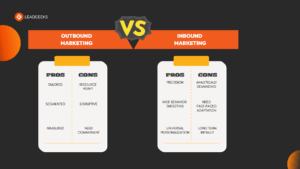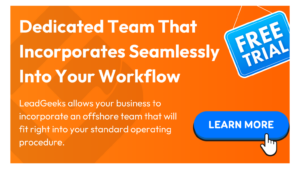In coming up with effective Business to Business marketing strategies, businesses face a critical choice: should they lean on the proactive, direct nature of outbound marketing or embrace the magnetic pull of inbound marketing techniques? Outbound marketing, once defined by mass marketing tactics like cold calls and generic mail, has evolved to become more targeted and personalized. Inbound marketing, initially gaining traction through SEO and content marketing, aims to draw in leads by providing value first.
But, the questions still stands: which approach would fit your business? As Business to Business marketing strategies mature, understanding their evolution is key to integrating them effectively for a modern and powerful B2B marketing strategy.

Outbound : Mass mailings to Personalized
Outbound marketing has shifted from a broad-brush approach to a finely tuned strategy that aligns with contemporary expectations of personal relevance and timely engagement.
Pros in Doing Personalized Outbound
Tailored Interaction
Modern outbound strategies prioritize personalized communication tailored to each prospect’s position in the sales funnel, encouraging deeper engagement. This personalized approach ensures that prospects receive messages that resonate with their specific needs and challenges, increasing the likelihood of conversion.
To drive this point home, lets cover each stage of the sales funnel and how you could tailor a personalized interaction in each of them:
Funnel-Specific Interactions
- Awareness Stage. As in this stage you are still a stranger to the prospect you’re reaching out to in outbound, building a connection is required. Look into their social media such as Linkedin and try to find a common ground. For example, if they just came back from a tradeshow, you could build a connection by asking about their activities there. Once the opportunity opens, send them educational blogs or whitepaper that could be related to your brand to give them value.
- Consideration Stage. Once you’ve got them in the ropes, you will need to convince them to pick you. In this free market place, it is important for your brand to stand out against the rest that are similar. Provide them with case studies that show how especially effective your product/service is. If possible, you could also make a comparison chart of how your product perform compared to your competitors!
- Decision Stage. With them now fully interested in what you offer, you are now in the final stretch of your outbound. If you’ve done enough research on your prospect, you should have an idea of what they could or could not afford. Before sending an invitation to call, make sure to ask if they have any specific queries and provide helpful information that can accelerate the decision making before the call is made. Usually the reason why closed-loss happen during this stage in outbound is because cost related reasons. If possible, make an offer that fits the prospect. For example, if the prospect is a startup, make sure you provide a more flexible pricing model.
Advanced Segmentation in Outbound
Utilizing modern tools, marketers can segment their audience with precision, directing resources towards high-potential leads for maximum impact. By segmenting their audience based on factors such as demographics, behavior, and purchase history, marketers can deliver targeted messages that are more likely to resonate with each segment.
More Measured Outreach
Outbound marketing allows for the tracking and measurement of campaign effectiveness in real-time, enabling marketers to make swift adjustments for better results. By monitoring key metrics such as open rates, click-through rates, and conversion rates, marketers can gain valuable insights into the effectiveness of their outbound campaigns and optimize them for maximum impact.
Cons in Doing Personalized Outbound:
Personalized Campaign is Resource Intensive
Implementing personalized outbound marketing requires significant investments in advanced software and skilled personnel. The development and execution of personalized campaigns require sophisticated marketing automation tools, customer relationship management (CRM) systems, and data analytics capabilities, all of which come with associated costs.
To give you an idea how resource intensive a personalized campaign is, lets breakdown the resources used for each personalized campaign.
Personalized Campaign Cost Breakdown
- Software Costs. Recent tools that allows you to better gather intent data can be overwhelmingly costly. In general, some intent data tools can reach around 1000-5000 USD/month
- Talented Human Resources. From copywriters who makes each email drafts to ISRs who keep up with each prospect, the cost of paying their salaries can stack up. Staying up-to-date with personalization is a hard ask, so the cost could range from 80000 USD/year to 100000 USD/year
- Time-consuming. As you will need to keep up with your prospect’s updates to keep your message personalized, you would need to take time out of your workday to do daily research on them before engaging every time. Not to mention, the process of crafting and optimizing the campaigns itself will take a long time.
Perceived Disruption from Outbound
Despite efforts to personalize, outbound marketing runs the risk of interrupting or annoying prospects if not carefully aligned with their preferences. Even personalized messages can be perceived as intrusive if they are not relevant or timely, leading to a negative brand perception and a loss of trust among prospects.
How Personalization Could Backfire
- Overstepping privacy. Lets say your personalized message was “I noticed you’ve been attending x tradeshow.” Starting with that as your opening line can be seen as suspicious (not to mention, creepy).
- Irrelevant Personalization. Not all personalization are good personalization. Emailing them about the weather in x tradeshow is not only going to make them confused about your email’s intentions, but also take away the advantage of making your email concise.
Greater Time Commitment
I mentioned this before, but I’d like to emphasize it here. Crafting and refining a custom-tailored outbound strategy demands ongoing time and resources to ensure effectiveness and relevance. Marketers must invest time in conducting market research, developing buyer personas, creating personalized content, and continuously monitoring and optimizing campaigns to stay ahead of the competition.
Inbound : Content to Context
Inbound marketing has always aimed to attract customers through relevant and helpful content. Over time, it has become more strategic and data-focused.
Pros in Contextual Inbound:
Content Precision
By leveraging user data, inbound marketing produces highly targeted content that addresses specific niches, pain points, and stages in the buyer’s journey. By analyzing data such as search queries, website interactions, and social media engagement, marketers can gain insights into the topics and content formats that resonate most with their target audience and tailor their content accordingly.
Here are some ideas you could use in making a precise contextual content for inbound.
Making Data-Powered Content
- Keyword Clustering. After you analyzed data such as search queries, you should be able to have many effective keywords you can use to make content with. We’ll take that a step further by connecting the keywords you found into relevant, long-tail keywords. For example, if you sell a 3D Bioprinter. Instead of just using “3D Bioprinter” as your keyword, you can join it together with others like “Most precise 3D Bioprinter”
- Filling the Content Gap. Using tools like SEMrush, you will be able to have an idea of what keywords and topics that your competitor rank in the SERP for but you don’t. This means you’ll be able to see what kind of content you haven’t talked about and increase more content in that area; broadening your reach.
Behavioral Targeting
Utilizing user interactions and engagement metrics, inbound strategies are fine-tuned to create personalized experiences that resonate with individual prospects. By tracking user behavior across various touchpoints, marketers can identify where prospects are in the buyer’s journey and deliver content that is relevant and timely, increasing the likelihood of conversion.
Lets cover some behaviors you can make use of in making your contextual inbound more effective!
Actions To Take with Specific Behavior
- Dynamic Content. This kind of content would be very effective in meeting the prospect depending on where they are in the sales funnel. Depending on your website’s visitor’s behavior, a different CTA will pop up. For example, if they are visiting a product page, a pop up saying “See Technical Specs” will appear, directing them to the full technical information on that specific product.
- Retargeting Sequence. This action is geared more towards convincing a visitor to convert during their visit. For example, if a visitor goes to a pricing page and goes back to the main page, it will trigger an chatbot asking if they needed help
Scalable Personalization
Through the use of marketing automation and advanced data analysis, inbound marketers can personalize content at scale without significantly increasing resource investments. By automating tasks such as lead scoring, email segmentation, and content delivery, marketers can deliver personalized experiences to large audiences without the need for manual intervention, allowing them to scale their efforts effectively.
Cons in Contextual Inbound:
Analytical Demands
Adapting inbound marketing requires extensive data analysis and interpretation to derive actionable insights and optimize strategies effectively. Marketers must invest time and resources in collecting, analyzing, and interpreting data from various sources to gain a comprehensive understanding of their target audience and their behavior.
Fast-Paced Adaptation
Keeping up with the rapidly changing landscape of search algorithms and user behavior necessitates continuous updates and adjustments to inbound marketing strategies. Marketers must stay abreast of industry trends, algorithm updates, and changes in consumer behavior to ensure that their strategies remain relevant and effective.
Long-Term Play
While inbound strategies offer long-term benefits, they often require patience as results may take time to develop and may not yield immediate ROI (Returns on Investment). Marketers must set realistic expectations and understand that inbound marketing is a marathon, not a sprint, requiring consistent effort and investment over time to achieve meaningful results.
So, Outbound or Inbound?
With how the current Business to Business marketing has evolved, the debate of outbound versus inbound is one that may lead to an oversimplified belief of both. Both strategies have not only adapted to modern marketing needs, but also serve as a powerful force when worked together.
Blending the direct engagement power of outbound marketing with the customer-centric nurturing of inbound marketing allows companies to craft powerful and integrated Business to Business marketing strategies. This approach combines proactive outreach with magnetic content, ensuring businesses not only capture leads but also build lasting relationships with potential clients. A balanced strategy harnesses both aggressive targeting and organic attraction, perfectly suited for a dynamic and demanding business environment.
Of course, being able to tackle both of these approach is going to be resource-heavy to most companies. Already have an optimized outbound or inbound strategies in place but afraid of cutting corners when allocating resources to the one you haven’t optimized? Why not try LeadGeeks? Our customizable service allows us to adapt to your lead generation needs!
Want to know more? Click below to get started!

















1 Comment